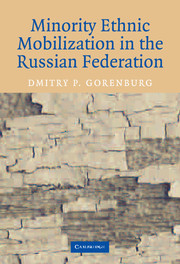Book contents
- Frontmatter
- Contents
- List of Figures and Tables
- Preface
- 1 Minority Ethnic Mobilization in Russia: An Introduction
- 2 Explaining Ethnic Mobilization: The Role of Ethnic Institutions
- 3 From Cultural Society to Popular Front: The Formation and Development of Nationalist Organizations
- 4 The Soviet Institutional Legacy and Ethno-Nationalist Ideology
- 5 Institutions Matter: Measuring Support for Nationalism
- 6 Intragroup Variation in Support for Nationalism: Not All Ethnics Are the Same
- 7 Outcomes: Did Regional Governments Adopt the Nationalist Agenda?
- 8 The Larger Picture: Support for Nationalism in Russia's Other Republics
- 9 Institutions and Nationalism
- Appendix: Construction of Variables and Indices
- References
- Index
Appendix: Construction of Variables and Indices
Published online by Cambridge University Press: 15 December 2009
- Frontmatter
- Contents
- List of Figures and Tables
- Preface
- 1 Minority Ethnic Mobilization in Russia: An Introduction
- 2 Explaining Ethnic Mobilization: The Role of Ethnic Institutions
- 3 From Cultural Society to Popular Front: The Formation and Development of Nationalist Organizations
- 4 The Soviet Institutional Legacy and Ethno-Nationalist Ideology
- 5 Institutions Matter: Measuring Support for Nationalism
- 6 Intragroup Variation in Support for Nationalism: Not All Ethnics Are the Same
- 7 Outcomes: Did Regional Governments Adopt the Nationalist Agenda?
- 8 The Larger Picture: Support for Nationalism in Russia's Other Republics
- 9 Institutions and Nationalism
- Appendix: Construction of Variables and Indices
- References
- Index
Summary
Creation of Explanatory Variables
With several important exceptions, the explanatory variables used in the statistical analysis are either indexes or dichotomous variables. The latter are used to identify respondents who belong to particular occupational groups or who share particular social characteristics or beliefs.
Occupational Groups
Intellectual: This category includes all respondents who identified themselves as working in the field of science, culture, or education.
Student: This category includes all respondents who identified themselves as either full-time or part-time students.
Industrial worker: This category includes all respondents who, when asked about the group to which they belonged, identified themselves as workers.
Agricultural worker: This category includes all respondents who, when asked about the group to which they belonged, identified themselves as workers at a collective farm (kolkhoz) or state farm (sovkhoz).
Leader: This category includes all respondents who, when asked about the group to which they belonged, identified themselves as managers or supervisors.
Social Characteristics
Community size: The value of this variable is based on the respondent's place of residence at the time of the interview. The values were initially arranged as follows:
1 = capital,
2 = city,
3 = town,
4 = village.
Migrant: This category includes all respondents who had spent the majority of their childhood in a rural area but were living in a city at the time that the survey was conducted.
Education: This variable represents the respondent's level of education. The values were initially arranged as follows:
1 = illiterate or primary,
2 = incomplete secondary,
3 = secondary,
4 = specialized secondary,
5 = higher education,
6 = advanced degree.
Age: This variable represents the self-reported age of the respondent, divided by 100 for ease of comparison.
[…]
- Type
- Chapter
- Information
- Minority Ethnic Mobilization in the Russian Federation , pp. 272 - 278Publisher: Cambridge University PressPrint publication year: 2003



